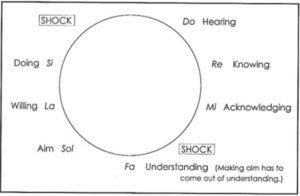The Work Octave
In the Work, the Law of Octaves (aka the Law of Seven or the Law of Order of Manifestation) is a template of organizing and explaining the evolution and experience of phenomena in seven stages or steps. The Work Octave describes the order of manifestation of our progress in the Work, beginning with Do, Re and Mi:
Do – Valuation of the Work: Wanting a new manifestation in our lives, we wish. We make effort to grow in knowledge of Work principles.
Re – Application of Work ideas: We do not accept Work principles at face value but verify them for ourselves. We apply them in our own lives – to our own being.
Mi – Realization of personal difficulty: Through self-observation, we acknowledge patterns and mechanical behavior in ourselves that have kept us from healing and growth.
The first three steps are the ones most spoken about in the Work, because for a long time, we cannot get beyond them. And so we begin again at Do; our wish – our valuation – becomes stronger.
“If you have no self-observation, if you cannot act more consciously at a particular moment when things are difficult, you will continue to lay down in yourself the same pattern. You may flirt with the Work as many people do, you may think it is interesting, but remember that the Work Octave starts with evaluation [i.e. to value the Work] as Do, and application of the ideas to yourself as Re. Certainly this is a big step. Remember that you are the subject of the Work, you yourself. The Work is not something outside you. It has to come into you, or, you have to put it inside yourself and begin to live from it and view everything that you do and think and feel from the power of the Work. When this begins your whole memory of everything, of yourself, of other people, of your past tribulations – and remember that everyone makes so many internal accounts in life that each person secretly feels that he or she only has tribulations – will begin to alter. This is psychological transformation.”
– Maurice Nicoll, Commentaries, “Commentary on Memory,” January 7, 1945, Vol. 3, p. 592
“All our movements and actions are subject to the Law of Seven. They begin in one direction but cannot pass the interval in the octave. We go up to the note mi and return to do. To go further, there must be an additional force from within and from without. Today it is mainly our head, our thought, that is touched by the Work. The body and the feeling are indifferent and recognize no demand so long as they are content. They live in the moment itself and their memory is short. Yet the wish must come from the feeling, and the power to do, the ‘capacity,’ must come from the body. These separate parts each have a different attention, whose force and duration depend on the material they have received. The part that has received more material has more attention. …
“In the ascending octave toward consciousness, remembering oneself is the shock that is necessary to pass the interval between mi and fa – the first conscious shock. It brings a force that can only come from the wish, the will. We must make the will grow degree by degree, step by step.”
– Jeanne de Salzmann, The Reality of Being
“I want to talk about crossing this Mi-Fa gap. This is how Dr. Nicoll represented the Work octave for us on a smaller scale in his own private diagram [see diagram below]. … The gap at Mi cannot finally be crossed for a long time, but it can be represented many times on small scale. You have to cross the gap many times before you finally cross it. … First an idea is repeated in the group. … Some will dismiss the idea, thinking they’ve heard it before. Some resist it. And some hear it only vaguely. But after many repetitions someone may hear it [Do]. And then at the next meeting someone else may hear another idea, and so on. Then they know the idea. That is the second stage [Re]. Then there is a further stage of acknowledging it by applying it to oneself [Mi]. Then comes the next stage, understanding. There is a bigger gap here, between acknowledging and understanding [the Mi-Fa interval]. Understanding comes from acting according to what you have acknowledged in yourself, and then it becomes part of your being. … Then the octave continues and goes much faster – deciding, willing, doing.

Diagram 12. An octave of learning.
“X: On the right side, Do-Re-Mi, we remember after we act; and on the left side, Fa-Sol-La-Si, we remember before we act.
“MRS. POGSON: Yes, that is a good description. Every small increase in understanding makes you realize how much more there is to understand. … There can be many octaves like this.”
– Beryl Pogson, The Work Life